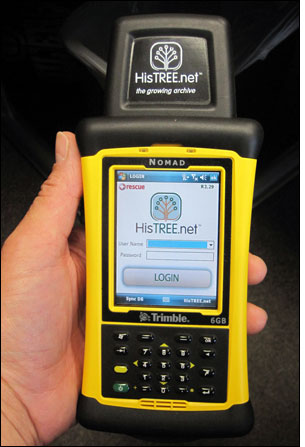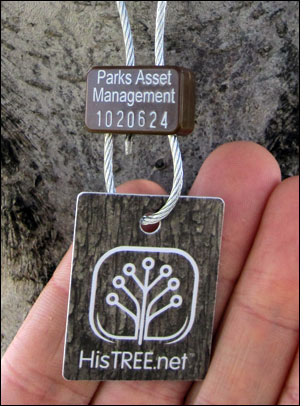Apr 28, 2011When workers maintain trees and parks or empty public garbage cans in Fort Saskatchewan, a city of 18,000 residents in Alberta, Canada, they keep record of their daily activities via radio frequency identification. By reading passive ultrahigh-frequency (UHF) EPC Gen 2 RFID tags attached to the lower limbs of trees, bolted to garbage cans or adhered to swing sets, as well as tags buried in the soil, staff members not only can update city records regarding maintenance status, they can also access details about when an item, such as a tree or a piece of playground equipment, was last serviced, as well as how and by whom.
The city began installing the tags—provided by HisTree.net, a company based in nearby Edmonton—on hundreds of its trees early this year, and is now also attaching the tags to playground equipment, bolting them to garbage cans and burying then underground at city parks, says Chris Enders, the city's superintendent of parks and facilities management. HisTree.net is also supplying handheld readers and a hosted software application.
According to Enders, the solution began simply as a way to track the city's thousands of trees, to ensure that they are properly maintained with such services as watering and pruning. When installing new trees in Fort Saskatchewan, developers hire contractors to maintain those trees for the first two years of their lives, before turning their care over to the city, with a guarantee that they were well cared for. Without an RFID system, Enders says, the city can merely conduct visual inspections of those trees during that two-year period, checking whether they are being maintained as expected. With the HisTree.net system, however, the city can keep a record of every tree's maintenance history.
After a developer plants trees, a contractor attaches a UHF EPC Gen 2 passive to each tree, by means of a wire cable loop around a lower limb, and then locks it place. The cable passes through a hole, and then a second hole for locking, at which time it is snapped shut and can sustain a 700-pound pull. The tags, manufactured by GAO RFID, consist of an Alien Technology ALN-9629 Square RFID inlay encased in a protective plastic shell. Each tag is encoded with a unique ID number. The contractors employ a handheld interrogator to read tags attached to the trees whenever they are serviced (HisTree.net leases Trimble Nomad readers to the contractors for that purpose). When the tag is first input into the system, it is read by the contractor, and data about the tree—such as its age, species and size—is input into the handheld device. The information is then forwarded via a Wi-Fi connection to the back-end server hosted by Histree.net when within range of a Wi-Fi node, or via a GSM cellular connection, explains Art Maat, HisTree.net's president.
When maintaining a tree—for example, adding water, fertilizer or pruning—a contractor first reads its tag, then inputs data indicating which services were provided. The city can then use a password to log onto HisTree.net's Web site and access that information. In that way, if the city notices that a particular tree looks unhealthy, for instance, it can access that tree's data online and determine how well it is being maintained.
The city began by tagging several hundred trees, Enders says, but eventually intends to tag its entire inventory, which could amount to more than 10,000 trees—though that, he notes, would occur in stages. Once the tree system went live about two months ago, Enders says, he began to notice other applications for the technology.

When city workers maintain playground equipment in Fort Saskatchewan's many parks, for example, they can now utilize RFID to record that activity electronically. The city is attaching an adhesive RFID tag to each piece of equipment on playgrounds throughout the town, and is using a Nomad handheld to input data about that equipment. From that point onward, employees will be able to use the HisTree.net system to record every inspection or repair task performed on that equipment. Staff members first read the tag, and then enter data—such as what is being inspected, the results of that inspection and any maintenance requirements—using a dropdown menu on the handheld. In that way, if a piece of equipment were to fail, the city would have a record of its maintenance and inspections. In addition, the data can be used to detect when a piece of equipment has not been inspected. Initially, the city is tagging approximately 30 playgrounds.
In addition, Fort Saskatchewan has begun bolting HisTree.net tags to 480 public garbage cans, in order to track how often they are being emptied. In the past, Enders explains, the city has received complaints that garbage cans were not emptied, when in fact, they may have been emptied on schedule, but no paper or electronic record could prove that action had occurred. With the use of the HisTree.net system, sanitation workers can read a trash receptacle's tag and select an action on the handheld's dropdown menu, such as emptying the can. If a garbage can were damaged—for example, if it were hit by a car—that incident could be entered into the system. The city would then replace the damaged can, remove its tag and bolt it onto a new can, so as to provide a history of both the old and replacement garbage cans. This type of information can help the city understand more about not just the trash receptacle itself, but also the area, such as determining if a garbage can needs to be relocated because several previous cans had been hit by cars at that location.
The city is also utilizing the system to track maintenance at 10 of its parks. At each park, a small plastic cup with a lid is buried just below the lawn surface, with an RFID tag inside it. The cup's lid is flush with the surface and exposed, so that employees can see the tag's location and read it with a handheld interrogator. Upon arriving to mow the lawn or water the trees, flowers and shrubs, a worker uses a Nomad handheld to read the tag, input the type of work being performed in the park, and then begin that task. Although the city currently has two handheld readers to interrogate tags on trees, garbage cans and playground equipment in the parks, it plans to acquire a total of four by this summer.
In the future, Enders says he envisions using the system to track city signage, including stop signs, that may have to be replaced, and records of those events can be stored in the HisTree.net system, based on reads of tags attached to each sign pole. He would also like the city to use the tags to track fire-hydrant maintenance.
The city expects to budget up to $50,000 annually for the solution on all hard assets in the parks system, though Maat notes that initially, it is unlikely to use the entire budget. Enders expects a return on investment, but indicates that it is too early to calculate the amount of money that the city might save as a result of using the solution.
In the meantime, Enders hopes that nurseries will provide trees with RFID tags already attached, so that Fort Saskatchewan can view data about each tree from the time a seed is planted. As the trees grow, he says, staff members will use a pole to extend the handheld reader's reach. The HisTree.net system has also been implemented at Canadian wholesale tree nursery Stewart Brothers Nurseries (SBM), located in Kelowna, B.C., which is applying a tag to each tree and storing data about that tree, including its species, the planting date and its maintenance record. That information, Maat says, can then also be accessed by customers such as Fort Saskatchewan.
HisTree.net makes the data available for an annual fee (typically ranging from $2,000 to $5,000 per year), and leases or rents hardware at a monthly or annual rate.


